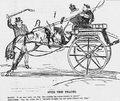Knock out
When kicking (also kicking out ), the horse , donkey or mule lifts both hind legs and kicks backwards. If only one hind leg is involved, it is called kicking.
This behavior can be shown out of a zest for life, for example when a foal storms away in the pasture . It can be shown in conflict with other horses, mostly as a defense when the horse feels harassed. The kicking out is mostly used as a warning. However, if a horse kicks out deliberately, it is very dangerous.
education
It is the goal of every horse training to control such behavior in handling. Basically you never approach a horse from behind in the blind spot , but from the side. In addition, the horse must be spoken to so that it does not get frightened. You don't go around the back of the horse either, but keep such a large distance that the horse cannot reach the person when it is kicked and speaks to the horse all the time so that it always knows where the person is even in the blind spot . Consideration must be given to the horse so that it does not get into situations in which it feels pressured. Then trust can be built through careful familiarization. With increasing trust, the horse's tolerance threshold shifts upwards. Careless behavior and reckless behavior towards the horse can also train a horse to hit. For example, some herding dogs ( border collies ) tend to snap at horse legs. The horse responds by kicking or hitting. This can lead to a habit.
Labelling
A horse that tends to kick is called a bat. Such a horse is not only dangerous in everyday contact, but also when it comes into contact with other horses, for example at rides or events. In a group with well-known horses, care is taken and a sufficient distance is kept from the bat. It must not be ridden too close and sufficient distance between the horses must be kept when overtaking. In general, a club should not go in the middle of a group or in front, but to the side or back.
At horse events, clubs must be marked with a red ribbon in their tail. This means that it is immediately apparent that increased caution is required and that a corresponding safety distance must be maintained.
Drive
This behavior is particularly dangerous in front of the wagon because the horse can go overboard . It can injure itself on the car, endanger the driver, or if it lands with one leg outside of the cords, it can no longer run properly.
Tests in equestrian sport
In equestrian tests , knocking out is usually considered disobedience , depending on the type of test , for example in dressage tests and serenity tests . When jumping , however, it is not penalized.
high school
In the High School, the knocking is painting called. When Cadre Noir , there is a lesson that Croupade , is shown in the painting. Even with the caper stroking horse.
Racket marked with a red ribbon in the tail, Hanshin Racecourse , 2014
Carriage horse that goes wild , caricature, 1898
Individual evidence
- ↑ Jesse Beery's practical system of colt training , Jesse Beery, p. 46, Lima Ohio, 1890
- ↑ Safe riding & driving in traffic , ProPferd.at, November 28, 2015






